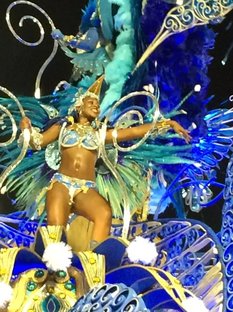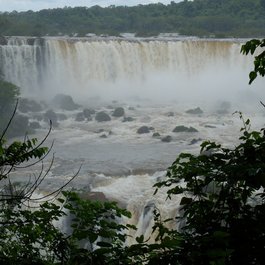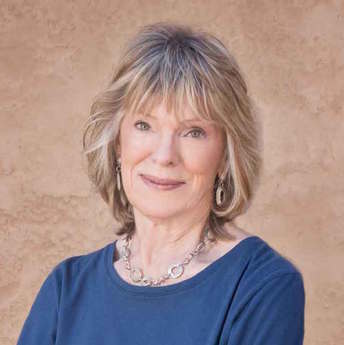 How often does fear, real or imagined, influence the choices you make? Prevent you from doing things you later regret? A distressing emotion, fear can sometimes override common sense. Other times it might save your life. Knowing the difference is key. Watching the televised opening of the 2016 Olympics in Rio de Janeiro last summer brought it home – Brazil’s spectacular natural and man-made wonders, diverse ethnicities, Brazilians’ exuberance, passion for partying despite economic and political challenges – and to think we nearly missed experiencing these because of the fear factor. Last February, bombarded by a flurry of headlines in local and national newspapers screaming Zika in Brazil and warnings by friends of likely crimnal encounters, my husband Frank and I flew to Rio de Janeiro for Carnival. Zika, a virus carried by an infected Aedes mosquito, is linked to microcephaly in newborns whose mothers, when pregnant, are bitten by the infected mosquito. In my seventies, I wasn’t about to get pregnant nor was Frank a likely Zika victim. Nonetheless, we packed a couple tubes of DEET insect repellent and left showy jewelry at home. “We don’t wear repellent,” our guide volunteered our first day in Rio de Janeiro. “Rio isn’t where Zika mosquitos are.” Great news, we thought, knowing Rio would be the site for golf and other sporting events in the 2016 Summer Olympics. Who knew that four world-famous male golfers, citing Zika fear, would opt against going to Brazil to compete in an event not played in the Olympics since 1904? Do they regret their decision? Mingling shoulder-to-shoulder with Brazilians on crowded subways from dazzling Copacabana Beach to the Hippi Market in Ipanema and on mountain-scaling funiculars to view Christ the Redeemer up close and Rio from on high, no one picked our pockets. Even in the Sambadrome arena with some 90,000 spectators witnessing samba competitions by schools of 3 – 4,000 costumed singers and dancers, some on floats two- and three-stories high, we had no unsavory experiences. Caught up in the jubilation of the crowd, we cheered – dancing in place – as each school paraded the length of the arena, about a half-mile, vying for the $5 milliion first prize. We lasted until 3 a.m., seeing three of six finalists. The entire competition runs from 9:30 p.m. to 6 a.m. on successive nights. Taken by our guide to Rocinah, a “safe” favela, we admired the clean streets and colorful slum houses dotting hillsides overlooking the Atlantic Ocean. Driving back down to the center of Rio, we stopped at a Brazilian steakhouse for succulent cuts of meat barbecued, in old gaucho tradition, on an open fire – an over-the-top experience for ambivalent carnivores. From Rio we flew southwest to Iguacu Falls to see the magnificent spectacle of 275 waterfalls creating thunderous, wondrous curtains of white that stretch nearly two miles wide and 200 or more feet high. Their source, the Iguacu River, forms the boundary between Brazil and Argentina. Wooden stairways brought us within arms-length of the rumbling falls, allowing us to sense the power of falling water, not a few gallons but millions of barrels. Still, no mosquitos. Up north in Manaus, awaiting a riverboat that would take us onto the Amazon and into the rain forest, we walked through the Adolpho Lisboa Municpal Market, a cast-iron replica in miniature of Paris’s Les Halles market building. Later, we ventured into the city’s famed opera house, the opulent Teatro Amazonas, where the Amazonas Philharmonic Orchestra was rehearsing Beethoven’s Ninth. Comfortably seated inside this Renaissance jewel built in the late 1800s, I let the music fill my body while my eyes feasted on tiers of gold-leafed columns, chandeliers (198 imported from Italy including some of Murano glass) and the ornate ceiling of painted panels depicting music, dance and drama. Only after leaving the opera house did I focus on its exterior – walls painted a dusty rose, accented by white columns, and a dome covered with thousands of ceramic tiles painted the colors of Brazil’s national flag – green, yellow, blue and a little white. We had expected Manaus to be a village dominated by the opera house built when fortunes were made in rubber. Instead, we found a city teeming with some two million inhabitants and an ever-growing presence of high-tech companies.  Our cruise on the Amazon and trek through the rain forest led by an indigenous tribesman who showed us how to survive in the forest left me with one regret. I’d hoped to see hundreds of wild birds, including toucans noted for their large colorful bills, but the birds were few and the only toucan I saw was in the Manaus zoo. After two weeks in Brazil, I’m hard-pressed to describe the looks of a Brazilian. Descendants of early settlers and post-colonial immigrants – Portuguese, Italian, Spaniards and Germans with large numbers of Japanese, Poles and Lebanese – African slaves and Brazil’s indigenous peoples, they, like those of us in the United States, are not a homogeneous lot. We were told that the largest Japanese community outside Japan – some 2 million -- lives in Sao Paulo. Our last day in Manaus a mosquito flitted by while I was eyeing souvenirs in a shop in our hotel complex. Wearing repellent, I was relatively fearless. According to one authority, our chances of being killed by a car in the U.S. are 17,400 times greater than contracting Zika from a mosquito in Brazil. If we’d given way to unexamined fear, we might never have experienced the richness of Brazil and Brazilians’ unabashed passions.
2 Comments
Pressed to come up with a subtitle for Banged-Up Heart -- in time for a poster display at my college reunion -- I quickly settled on A Widow’s Story of Star-Crossed Love. It wasn’t until many months later, about the time I landed a publisher, that I began to lament my hastily concocted subtitle. A potential reader might think my book was about a widow who falls in love with someone who dumps her, and that was not the case. Why hadn’t I seen that earlier? If a subtitle tells the reader what the memoir is about, what was my memoir really about? “Love and loss,” I said to my editor, who’d asked the question. She nodded her agreement. But the words “love and loss” alone seemed incomplete. What was it about love and loss that would give the reader insight into the essence of Banged-Up Heart?
My thoughts turned to the Anne Lamott Plan B piece where I’d found my title, and that’s when it hit me. The subtitle should say something about dancing. I ran a couple of possibilities by Terra Nova Books editor, Marty Gerber: “How about A Widow Dances with Love and Loss?” “Yes,” he said, “you were widowed at the start; yes, you’re twice widowed at the end. But in between is the story of two diverse individuals – powered by love—trying valiantly to know each other and find a way together to battle an overwhelming enemy. I simply feel that the ‘human-ness’ of the tale you tell is so much more than the ‘widow-ness’ angle.” “How about A Dance with Love and Loss?” I asked. “It’s not a single dance,” he said. “You’re dancing with love and loss from beginning to end.” And that’s how the subtitle, Dancing with Love and Loss, came to be. Sometimes it takes time and distance to be able to re-focus effectively on the essence of what you’ve written. And having the reaction of someone else, such as editor Marty Gerber, can prove invaluable.  “Send your creative works for display at Reunion.” My college reunion was three months off but, regrettably, my memoir, my creative work, was not finished. I was still rewriting with no likelihood of completing it in time. But what an opportunity to promote it! I thought. I might even find the name of a literary agent from an author classmate. My editor agreed. With her encouragement, I met with Amiel Gervers, a tall brunette who’d left an advertising career in New York City to live in Santa Fe, New Mexico. “Shirley, I can design a website for your book, and I can have it finished with posters and postcards in time for your college reunion.” Stirring sugar into her tea at the Teahouse on Canyon Road, Amiel told me what she’d need. “First, I want to read your book. I know you haven’t finished rewriting it, but that’s all right. I want to select quotes to go with some of these photos you’ve shown me. You’ll need to send these to me electronically. Also, I’ll need a bio from you and while you at it, something about your “Tahoe Traveler” writing experience. In my twenties, I’d traveled in Europe and the Middle East, writing a column for the Tahoe Daily Tribune. Within days, Amiel had everything she needed from me with one exception: a title for the book. I’d sent her a photo to use as a cover mock-up -- a burned out forest with nascent green grass denoting regrowth in the foreground. But I was still clueless about a title. Months earlier, I’d discarded a working title, Love + Loss x Two, because I’d narrowed my focus to my recent love and loss. Hoping for an epiphany, I hunkered down with the last several chapters. I would be discussing one, possibly more, of these with my editor in a few days. In one chapter, my attention riveted on a selection by writer Anne Lamott that the Rev. Kim Beach read at John’s memorial service. That’s it! I thought. Eager to share my find with editor Morgan Farley, I could hardly contain myself as I sat down at the table for our editing session. “I have a title!” I blurted. “So do I,” she said. “Banged-Up Heart,” I said. “That’s what I came up with, too.” Morgan beamed with delight. And that’s the story of how I found a title for my memoir – in time to promote it at my college Reunion. Since then, the cover has changed but the title remains.  A few months after my husband’s death, I told close friends I was going to write about my life with him, cut short two years after we married. I felt blindsided, but by what I didn’t know. By John? By my own naivete? I had to figure it out. A writer most of my life, I was comfortable putting pen to paper. Aided by a journal I’d kept and a boatload of emails I’d written during John’s last months, I set out to tell my bittersweet story. After two years of grieving for my first husband, I’d been swept up into a whirlwind romance by a younger man who was a rocket scientist. We married and created an adventurous new life together. We were supremely happy – and then I lost him to a brain tumor. Day and night, in Santa Fe and Reston, Va., I sat at the computer, my fingers flying across the keyboard, capturing the essence of my two-year odyssey. Friends read my drafts and came back with questions that caused me to re-think and re-write. Over tea at Collected Works Bookstore in Santa Fe, I handed my manuscript to editor Morgan Farley. “I’ve been writing for three years, and this is what I’ve produced,” I said. “I know there’s something missing but I don’t know what it is.” “I know what’s missing,” Morgan said in a phone call a couple of weeks later. Relief washing through my body, I grabbed a pen to schedule another meeting. “You have three books in one,” she began. “I’ve made a note of the pages devoted to each and would suggest you go with the one that has the most pages because that seems to be where your strongest energy is.” I’d started off on the energized track, but a close friend who’d known and loved my first husband Joe suggested I also write about my life with him. Once I’d done that I thought, Why not write about my life before Joe – about Nikos in Greece and while I’m at it, my troubled mother? Back on track, I listened to Morgan talk about the craft of novel writing and how it applies to writing memoir. She explained that a story comes alive when you create scenes to show action, and use dialogue to reveal personality and character. We talked about using description but not too much, to allow the reader to use her imagination, and pacing by relieving highly charged scenes with narrative while keeping the story moving. It was a lot for me to absorb. A history major in college, I hadn’t read many novels; I’d read original sources and become practiced at critiquing authors’ premises and their use of sources to back them. Later, in my professional life, I did a lot of business writing – press releases where scene-setting meant naming the place where a meeting was held and dialogue meant adding direct quotations by speakers that revealed neither personality nor character. Rewriting my memoir to give it the missing ingredients sounded challenging. “If you choose to do this, it will be transformative,” Morgan said. Over the ensuing months, Morgan frequently asked, “What were you feeling?” – inviting me to dig deep for my interior emotional state. She helped me to confront my story as I lived it, subjectively, and to reflect, time and again, on the significance of my feelings, thoughts and actions. Looking deep inside to find my truths, when I wasn’t by inclination introspective, challenged me. Having the courage to put them on paper, even those I might not like, meant overcoming my own inhibitions and ignoring the advice of well-meaning friends who believed personal publicity of any sort should be limited to births, marriages and deaths. “It’s too personal,” a good friend confided after reading the first several pages. The greatest joy in writing Banged-Up Heart was hearing Morgan say, “Beautiful, beautifully expressed.” Or, “I just kept reading, forgetting I was supposed to be editing.” I also heard from Morgan, “Shirley, I’m sorry but this doesn’t work.” And I’d toss eight hours worth of carefully crafted prose. The successive joys of landing a top-notch agent, Liz Trupin-Pulli, and a publisher, Terra Nova Books, are more than icing on the cake. They’ve made it possible for me to bring my years of hard work to fruition. |
Author BLOG
I'm Shirley Melis. You may know me as Shirley M. Nagelschmidt, Shirley M. Bessey and now, Shirley M. Hirsch. Each reflects a particular phase of my life. Banged-Up Heart is a slice of my life's journey and in telling my story, I'm giving voice to my long silent "M" by reclaiming my maiden name, Shirley Melis. Archives
January 2024
Categories
All
|

 RSS Feed
RSS Feed